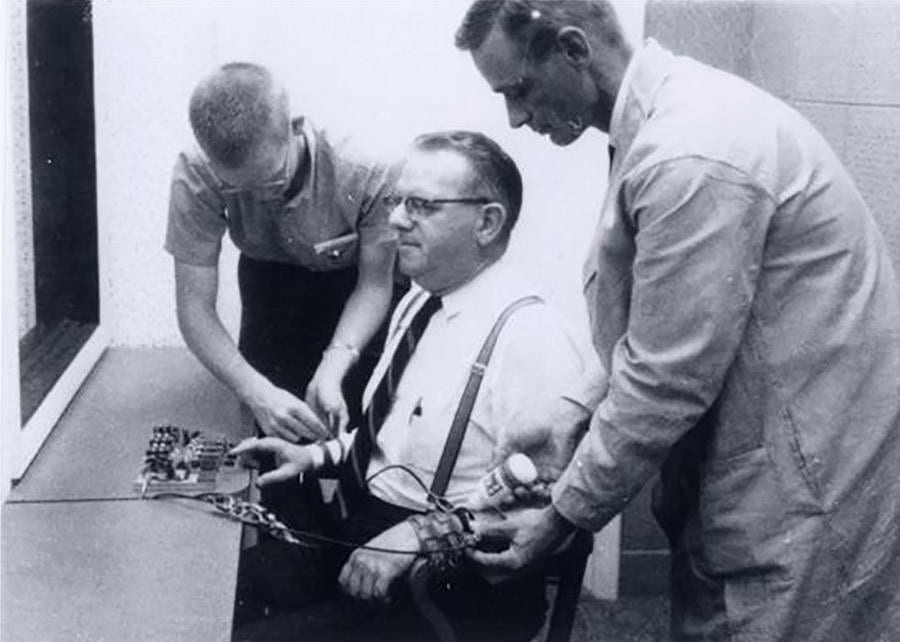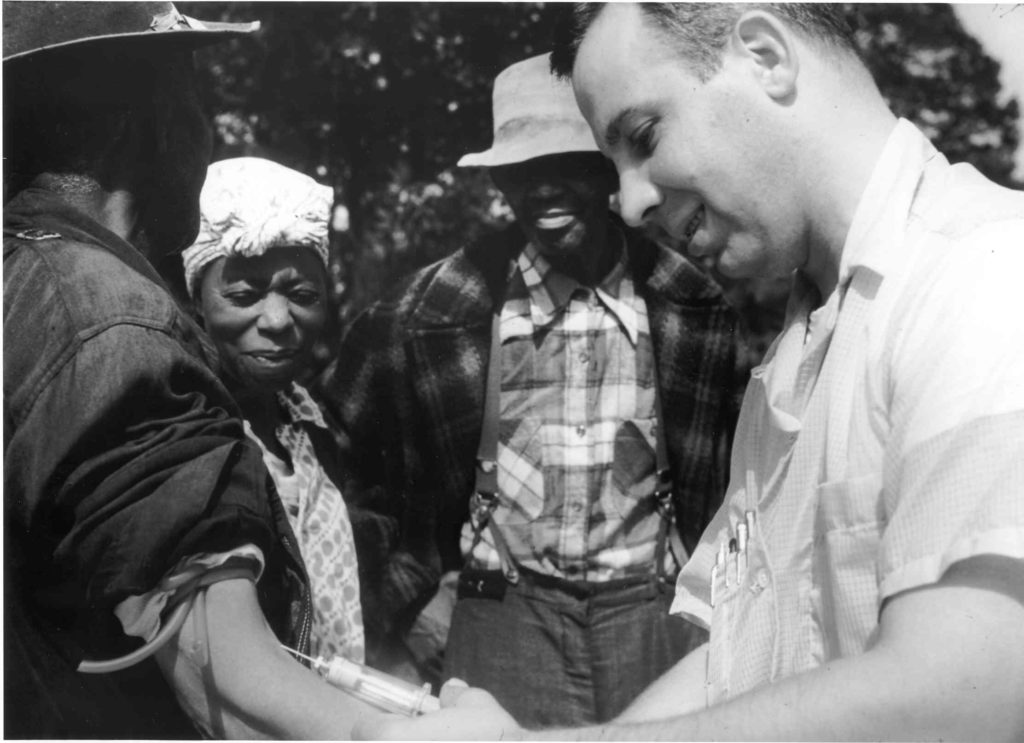In the dark days of psychology, humans were often subject to unethical treatments and experiments. We would lobotomise the mentally ill, perform experiments on children, and use prisoners as lab rats.
But, from an academic standpoint, ethically reprehensible, horrifying experimental psychology from the past has taught us a lot about the human psyche.
Does that make it okay they happened? Of course not. But this makes it even more important to analyse what they taught us about human beings and what makes us tick. The wild west of unethical psychological experiments is mostly a thing of the past, but the ramifications have driven psychologists to follow the code of ethics they adhere to today.
This list is the top 7 most horrifying psychological experiments performed on human beings—and what they taught us.
7. The Learned Helplessness Experiment, 1967
Martin Seligman is an American psychologist whose work focussed on depression and its effect on the human psyche.
Inspired by Pavlov’s work on classical conditioning, he began a series of psychological experiments that led him to develop his theory of ‘learned helplessness.’
Seligman did many variations of the learned helplessness experiment over the years, but we’ll look here at one of the earliest versions.
What is Learned Helplessness?
Seligman originally devised the laboratory experiment as an extension of his work on depression. Like Pavlov, he used dogs in his experiments, but instead of ringing a bell, he administered an electric shock.
He divided the dogs into 3 groups:
- the first experienced no shock
- the second were shocked with no way to avoid it
- the third were shocked but could prevent it by hitting a button with their nose
Once the dogs displayed understanding of their ‘fate’, Seligman moved on to part 2 of the experiment—confirming learned helplessness. He placed a dog in a chamber, split in two, with a low wall and one half electrified.

The dogs who weren’t shocked, or who prevented their shock in the previous experiment, soon learned to jump the barrier. The dogs in the last group, however (the group with no escape), resigned themselves to their fate, lying down and whining when shocked.
What it Taught Us About Perceived Control
Seligman concluded the third group of dogs assumed they had no control because of the earlier experiment. He theorised depression and related mental illnesses can lead you to believe you have no choice in the outcome of occurrences in your life; naming this the ‘perceived absence of control’ or ‘learned helplessness’.
6. Milgram’s Electric Shock Experiment,1961
Stanley Milgram’s Electric Shock Experiment is arguably the most famous experiment of all time.
During the experiment, participants sat in front of a line of switches, each labeled with an increasing voltage dose. The last three switches had skull and crossbones warning signs above them. A “Doctor” observes the experiment from the corner of the room.
The participants then ask general knowledge questions to another person whom they cannot see—but can hear via audio link. If the answer is incorrect; they flip a switch that administers an electric shock. As they move through the switches, the shock gets progressively worse and the other person cries out in pain and begs them to stop. Throughout, the Doctor in the room reassures them they are fine to continue.

Outcome: Milgram’s Participants Go Nuclear
Many displayed signs of distress when hearing the other person in pain. Despite this, every single test subject continued when urged to by the ‘doctor’.
Every single participant got to 300 volts—a lethal dose of electricity.
65% went all the way to 450 volts.
Of those 35% that didn’t get the entire way through the switch table—not a single person asked to check on the victim they had administered the shocks to.
What it Taught Us About Human Instinct and Authority
Does the Milgram experiment show us that all humans are capable of great evil and harm if the circumstances are right?
Milgram claimed the shock experiment proved humans felt an abdication of responsibility when an authority figure was present. In these circumstances, he believed we are all capable of committing atrocities; much like the Nazis in World War II. He drew comparisons to the concentration camps, claiming his experiment explained how the Holocaust could occur.
Many academics argue that this is too simplistic a view of the Holocaust and ignores the many other factors at play.
5. The Monster Study, 1939
Wendell Johnson conducted the ‘Monster Study’ at the University of Iowa, 1939. Its aim was to understand the cause and effect of stuttering.
He selected 22 orphan children aged 5-15. The children believed they were taking part in speech therapy and did not know they were part of a psychology experiment. By choosing orphans, he ensured there was no real adult advocate to ensure their rights were protected.
The study took place over six months with Johnson’s graduate student, Mary Tudor, undertaking most of the work.
The Psychological Experiment
Of the 22 children, they identified 10 as ‘stutterers’ prior to the start of the experiment. They were split into two groups; the first provided with positive reinforcement, and the second with negative. The 12 remaining orphans had no speech issues and were split between the two groups.
Those in the positive reinforcement group received compliments on their speech.
Those in the negative reinforcement group were told they were stuttering and needed immediate correctional help.
During Tudor’s first session with the children she told them that their speech was suffering and they would end up with severe stutters, lest they do everything in their power to prevent it. By the second session, Tudor noted immediate effects on the group labelled as ‘stutterers.’
Johnson’s colleagues, who were disgusted at the choice to use children, aptly named this horrifying psychological experiment ‘The Monster Study’.

What We Learned
The participants reported lifelong psychological and emotional mental health issues, and a continued reluctance to speak.
The Monster Study only came to widespread attention in 2001—at which point most of the participants had passed or were extremely elderly. The only surviving information on the Monster Study is the thesis written by Mary Tudor. The experiment’s results were never published; fearing it would draw comparisons to experiments by the Nazis.
Mary Tudor later regretted the study after seeing its effects. Stutterers in the negative group got worse and those with no prior issues became more reluctant to speak in public. One student who had no speech issues before the study even developed a “snapping” habit to help her speak.
The 3 surviving orphans were awarded $1.7m in compensation in 2007.
4. Stanford Prison Experiment, 1971
The Stanford Prison Experiment aimed to establish the cause of abuse by guards reported in American prisons.
Was it the personalities of the guards employed or the prison environment itself?
Dr. Philip Zimbardo used 24 college students for the social psychology experiment, assigning half the role of prisoner and half the position of guard.
Before the experiment began, the guards, whilst told not to cause physical harm, were told they had free rein to cause psychological harm.
Zimbardo told the guards:
“You can create in the prisoners feelings of boredom, a sense of fear to some degree, you can create a notion of arbitrariness that their life is totally controlled by us, by the system, you, me, and they’ll have no privacy … We’re going to take away their individuality in various ways. In general, what all this leads to is a sense of powerlessness. That is, in this situation we’ll have all the power and they’ll have none.”
To help foster authenticity, they arrested “prisoners” from their homes, fingerprinting and strip-searching them before putting them in jail.
The Stanford University prison experiment should have lasted 14 days. They abandoned it after just 6.

The Horrifying Psychological Impact
The psychological impact of their environment became apparent quickly as participants forgot their true identities and became absorbed in their roles.
A typical prison environment quickly developed. The guards took advantage, using their authority to force inmates to strip naked, defecate in buckets, and isolate them in solitary confinement. Prisoners snitched on each other, hoping to lessen their own abuse.
After only 36 hours, one prisoner suffered a mental break and had to be removed. Over the course of the next 6 days, the prison guard’s behavior continued to escalate dramatically and multiple more prisoners suffered emotional breakdowns.
Of 50 outsiders who viewed the experiment at this time, only one protested (Zimbardo’s own girlfriend). Zimbardo recognized he himself had become too immersed in his role (as the prison chief) and fallen prey to the psychological influence of the study.
After just 6 days, they canceled the experiment.
What it Taught Us
The Stanford Prison Experiment suggests people will comply with what is expected in their social environment. It shows that conformity can be stronger than morality in affecting human behavior.
It also raised the interesting philosophical question: can a good person commit abhorrent acts?
This experiment suggests that under the right circumstances, anyone can become a monster.
3. UCLA Schizophrenia Study, 1983
Prior to the 1970s, the stigma surrounding mental illness meant sufferers were often shut away in special facilities, or even lobotomised. During this decade, however, psychologists developed an interest in mental illness and its causes; questioning if later affliction could be predicted by earlier behaviors. Thus, the UCLA study of 1983 came to fruition.
Psychologists at UCLA wanted to find out what behaviors were predictors of schizophrenia and whether lifelong medication was beneficial or unnecessary for sufferers.
To study this, they asked 50 diagnosed schizophrenics to take part in a study that looked to discover if some schizophrenics do better without medication.

Outcome: What Happened Once the Drugs Left the Patient’s Systems
Despite signing “informed consent” forms, it was clear the participants did not understand the ramifications and potential consequences of coming off their medication.
Of the 50 participants, 23 suffered severe relapses. One had a mental break where he threatened his mother with a knife, before fleeing his family home and ending up halfway across the country.
Another man, Tony LaMadrid, tragically committed suicide by jumping off the top of a parking garage, after failing to contact the medical researchers.
Several families of the victims claimed they had been left in the throes of paranoid delusions for weeks. They said the doctors refused to reinstate their medication or help them. When the study ended, many sued.
What it Taught Us About Schizophrenia
The study continued until 1994, and the horrifying psychological implications are still discussed today. Overall, the researchers got off almost scot-free, despite it being recognized the study had several ‘failings’. One researcher, Dr. Keith Nuechterlein, remains at UCLA and insists they didn’t intend to drive patients to severe relapses. Others have pointed out that this was an inevitable and predictable side effect of their psychological research.
So, what did it teach us? Well, err… not much. Perhaps it confirmed taking mentally ill patients off medication can cause relapses in mental state… but I’m pretty sure we already knew that.
2. David Reimer and Gender Identity, 1965
As a baby, David Reimer was victim to a botched circumcision which left him without most of his penis.
His horrified parents turned to the psychiatrist Dr. John Money for advice. But Money, sensing his opportunity for a normally impossible study, convinced them they had to raise David as a girl.
David was a twin, and Dr. Money believed that by raising him as female whilst his twin was raised as male, he could prove gender identity was malleable and a result of nurture over nature.
David’s parents were under strict instructions to never tell him he had been born male. He spent his formative years as a girl, forced into dresses and “female” activities he hated. Throughout his youth, David received hormone injections to stimulate oestrogen and later had surgery for breast implants, amongst other “corrections”. Dr Money stayed connected to the Reimer family throughout the boys’ childhood, noting progress. The duration of the experiment, Dr Money insisted on his success, despite the blatant evidence to the contrary.
Disturbingly, he would also often force the twins to engage in pseudo-sexual acts. He’d photograph them in positions such as simulating doggy style; claiming it was necessary for healthy sexual and gender identity.

The Disturbing Outcome of the Psychological Experiment
By age 9, David Reimer was struggling with his female gender identity and hatred of Dr Money. By 12, he was experiencing depression and suicidal thoughts, and eventually, at 14, his parents confessed the truth of his childhood. David immediately stopped hormone treatments and began his transition back to male—but the psychological damage was done.
Sadly, the story does not end there. Both twins, scarred by the experiment, led troubled lives.
Brian, David’s twin, was later diagnosed with schizophrenia (unrelated) and at age 34, overdosed on pills and tragically died.
David lived another 4 years after his brother, but at age 38 he too succumbed to depression and committed suicide by shooting.
The Result: Nature or Nurture?
This is possibly the most horrifying psychological experiment in history, and psychologists still discuss the ramifications today. It played God with two babies’ lives, making them lifelong, unwilling participants.
If we can put aside the abject moral outrage for a second, this experiment taught us a lot about gender and identity.
Dr Money was sure that gender was learned—a case of nurture over nature. By lying about the study’s success, Money gave validity and a voice to anti-gender activists and set trans rights back decades. The impact of this was huge, leading physicians and doctors for the next 30 years to believe gender was malleable.
In reality, the experiment is a powerful piece of evidence to the contrary.
1. The Tuskegee Syphilis Experiments (1932-1972)
The Tuskegee Syphilis Experiment monitored the progression of syphilis in black males. Doctors claimed these men were ‘too stoic’ to accept medical treatment, so their observational experiment was merely a “study in nature.”
During the study, 600 Black males were told they were receiving treatment for ‘bad blood’ when in fact they received nothing but placebos. Of these men, 399 had syphilis and 201 did not. In exchange for their participation, the men received free medical exams, meals, and burial insurance.
The men involved were deliberately misled over the true meaning of the study. When penicillin emerged as an effective treatment of syphilis, the researchers horrifyingly hid this information from participants so they could continue to study the disease’s progression. They also then performed autopsies on the bodies of their victims – sorry, I mean, participants.
Over its 40-year span, the researchers changed their tune on its purpose several times; at one point claiming their syphilis was too advanced for penicillin to be beneficial.

The Outcome
128 died to help scientists prove the theory that black men wouldn’t ask for aid.
Countless black men suffered when penicillin could have managed or even cured their symptoms. Psychologists led by their own racial bias allowed these men to suffer and die to observe the path of progression in the body.
What it Taught Us
The belief that black men would not seek aid was a self-fulfilling prediction, as they never told those involved the severity of their illness, meaning they were less likely to seek treatment.
By the end of the study, the average life of Black American males had dropped by approximately 1.5 years. It led to a real unwillingness to seek treatment which has become ingrained in cultural consciousness. It’s believed we still see the effects of this to this day.

I had read about most of these cases before but it never stops surprising me. They seem to be taken out of a horror movie
This was a really interesting read. I knew about some of these but not all. Very informative!
Pingback: The Long Weekend Docket - The Mission Within